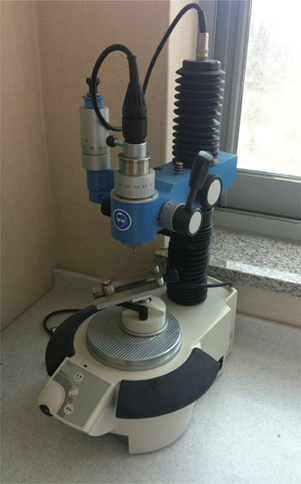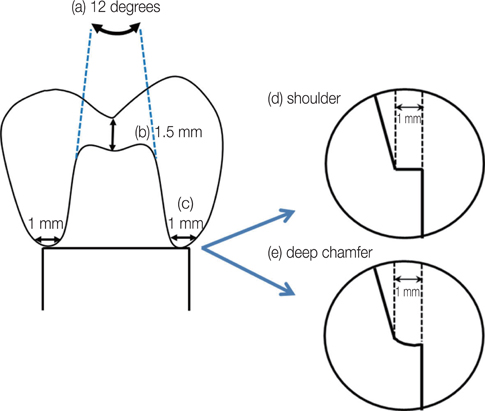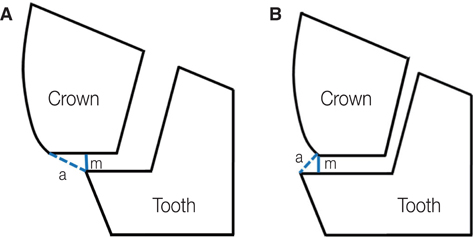J Adv Prosthodont.
2015 Aug;7(4):271-277. 10.4047/jap.2015.7.4.271.
Evaluation of marginal fit of 2 CAD-CAM anatomic contour zirconia crown systems and lithium disilicate glass-ceramic crown
- Affiliations
-
- 1Department of Prosthodontics, School of Dentistry, Chonnam National University, Gwangju, Republic of Korea. mcnihil@jnu.ac.kr
- 2RIS Foundation for Advanced Biomaterials, Chonnam National University, Gwangju, Republic of Korea.
- KMID: 2118262
- DOI: http://doi.org/10.4047/jap.2015.7.4.271
Abstract
- PURPOSE
This study was to evaluate the marginal fit of two CAD-CAM anatomic contour zirconia crown systems compared to lithium disilicate glass-ceramic crowns.
MATERIALS AND METHODS
Shoulder and deep chamfer margin were formed on each acrylic resin tooth model of a maxillary first premolar. Two CAD-CAM systems (Prettau(R)Zirconia and ZENOSTAR(R)ZR translucent) and lithium disilicate glass ceramic (IPS e.max(R)press) crowns were made (n=16). Each crown was bonded to stone dies with resin cement (Rely X Unicem). Marginal gap and absolute marginal discrepancy of crowns were measured using a light microscope equipped with a digital camera (Leica DFC295) magnified by a factor of 100. Two-way analysis of variance (ANOVA) and post-hoc Tukey's HSD test were conducted to analyze the significance of crown marginal fit regarding the finish line configuration and the fabrication system.
RESULTS
The mean marginal gap of lithium disilicate glass ceramic crowns (IPS e.max(R)press) was significantly lower than that of the CAD-CAM anatomic contour zirconia crown system (Prettau(R)Zirconia) (P<.05). Both fabrication systems and finish line configurations significantly influenced the absolute marginal discrepancy (P<.05).
CONCLUSION
The lithium disilicate glass ceramic crown (IPS e.max(R)press) had significantly smaller marginal gap than the CAD-CAM anatomic contour zirconia crown system (Prettau(R)Zirconia). In terms of absolute marginal discrepancy, the CAD-CAM anatomic contour zirconia crown system (ZENOSTAR(R)ZR translucent) had under-extended margin, whereas the CAD-CAM anatomic contour zirconia crown system (Prettau(R)Zirconia) and lithium disilicate glass ceramic crowns (IPS e.max(R)press) had overextended margins.
Keyword
MeSH Terms
Figure
Cited by 1 articles
-
Verification of a computer-aided replica technique for evaluating prosthesis adaptation using statistical agreement analysis
Hang-Nga Mai, Kyeong Eun Lee, Kyu-Bok Lee, Seung-Mi Jeong, Seok-Jae Lee, Cheong-Hee Lee, Seo-Young An, Du-Hyeong Lee
J Adv Prosthodont. 2017;9(5):358-363. doi: 10.4047/jap.2017.9.5.358.
Reference
-
1. Filser F, Kocher P, Weibel F, Lüthy H, Schärer P, Gauckler LJ. Reliability and strength of all-ceramic dental restorations fabricated by direct ceramic machining (DCM). Int J Comput Dent. 2001; 4:89–106.2. Conrad HJ, Seong WJ, Pesun IJ. Current ceramic materials and systems with clinical recommendations: a systematic review. J Prosthet Dent. 2007; 98:389–404.3. Christel P, Meunier A, Heller M, Torre JP, Peille CN. Mechanical properties and short-term in-vivo evaluation of yttrium-oxide-partially-stabilized zirconia. J Biomed Mater Res. 1989; 23:45–61.4. Kugel G, Perry RD, Aboushala A. Restoring anterior maxillary dentition using alumina- and zirconia-based CAD/CAM restorations. Compend Contin Educ Dent. 2003; 24:569–572. 5745765. Rekow D. Computer-aided design and manufacturing in dentistry: a review of the state of the art. J Prosthet Dent. 1987; 58:512–516.6. Yin L, Song XF, Song YL, Huang T, Li J. An overview of in vitro abrasive finishing & CAD/CAM of bioceramics in restorative dentistry. Int J Mach Tool Manuf. 2006; 46:1013–1026.7. Baig MR, Tan KB, Nicholls JI. Evaluation of the marginal fit of a zirconia ceramic computer-aided machined (CAM) crown system. J Prosthet Dent. 2010; 104:216–227.8. Preis V, Behr M, Kolbeck C, Hahnel S, Handel G, Rosentritt M. Wear performance of substructure ceramics and veneering porcelains. Dent Mater. 2011; 27:796–804.9. Jung YS, Lee JW, Choi YJ, Ahn JS, Shin SW, Huh JB. A study on the in-vitro wear of the natural tooth structure by opposing zirconia or dental porcelain. J Adv Prosthodont. 2010; 2:111–115.10. Felton DA, Kanoy BE, Bayne SC, Wirthman GP. Effect of in vivo crown margin discrepancies on periodontal health. J Prosthet Dent. 1991; 65:357–364.11. Knoernschild KL, Campbell SD. Periodontal tissue responses after insertion of artificial crowns and fixed partial dentures. J Prosthet Dent. 2000; 84:492–498.12. Kokubo Y, Ohkubo C, Tsumita M, Miyashita A, Vult von Steyern P, Fukushima S. Clinical marginal and internal gaps of Procera AllCeram crowns. J Oral Rehabil. 2005; 32:526–530.13. Boening KW, Wolf BH, Schmidt AE, Kästner K, Walter MH. Clinical fit of Procera AllCeram crowns. J Prosthet Dent. 2000; 84:419–424.14. May KB, Russell MM, Razzoog ME, Lang BR. Precision of fit: the Procera AllCeram crown. J Prosthet Dent. 1998; 80:394–404.15. Weaver JD, Johnson GH, Bales DJ. Marginal adaptation of castable ceramic crowns. J Prosthet Dent. 1991; 66:747–753.16. Behr M, Proff P, Kolbeck C, Langrieger S, Kunze J, Handel G, Rosentritt M. The bond strength of the resin-to-zirconia interface using different bonding concepts. J Mech Behav Biomed Mater. 2011; 4:2–8.17. McLean JW, von Fraunhofer JA. The estimation of cement film thickness by an in vivo technique. Br Dent J. 1971; 131:107–111.18. Martínez-Rus F, Suárez MJ, Rivera B, Pradíes G. Evaluation of the absolute marginal discrepancy of zirconia-based ceramic copings. J Prosthet Dent. 2011; 105:108–114.19. Pera P, Gilodi S, Bassi F, Carossa S. In vitro marginal adaptation of alumina porcelain ceramic crowns. J Prosthet Dent. 1994; 72:585–590.20. Cho SH, Chang WG, Lim BS, Lee YK. Effect of die spacer thickness on shear bond strength of porcelain laminate veneers. J Prosthet Dent. 2006; 95:201–208.21. Holmes JR, Bayne SC, Holland GA, Sulik WD. Considerations in measurement of marginal fit. J Prosthet Dent. 1989; 62:405–408.22. Blackman R, Baez R, Barghi N. Marginal accuracy and geometry of cast titanium copings. J Prosthet Dent. 1992; 67:435–440.23. Oruç S, Tulunoglu Y. Fit of titanium and a base metal alloy metal-ceramic crown. J Prosthet Dent. 2000; 83:314–318.24. Gavelis JR, Morency JD, Riley ED, Sozio RB. The effect of various finish line preparations on the marginal seal and occlusal seat of full crown preparations. J Prosthet Dent. 1981; 45:138–145.25. Han HS, Yang HS, Lim HP, Park YJ. Marginal accuracy and internal fit of machine-milled and cast titanium crowns. J Prosthet Dent. 2011; 106:191–197.26. Witkowski S, Komine F, Gerds T. Marginal accuracy of titanium copings fabricated by casting and CAD/CAM techniques. J Prosthet Dent. 2006; 96:47–52.27. Tan PL, Gratton DG, Diaz-Arnold AM, Holmes DC. An in vitro comparison of vertical marginal gaps of CAD/CAM titanium and conventional cast restorations. J Prosthodont. 2008; 17:378–383.28. Bornemann G, Lemelson S, Luthardt R. Innovative method for the analysis of the internal 3D fitting accuracy of Cerec-3 crowns. Int J Comput Dent. 2002; 5:177–182.29. Quante K, Ludwig K, Kern M. Marginal and internal fit of metal-ceramic crowns fabricated with a new laser melting technology. Dent Mater. 2008; 24:1311–1315.
- Full Text Links
- Actions
-
Cited
- CITED
-
- Close
- Share
- Similar articles
-
- Marginal fit of the digident CAD/CAM zirconia ceramic crowns
- Ceramic molar crown reproducibility by digital workflow manufacturing: An in vitro study
- Influence of porcelain veneering on the marginal fit of Digident and Lava CAD/CAM zirconia ceramic crowns
- Comparison of micro CT and cross-section technique for evaluation of marginal and internal fit of lithium disilicate crowns
- Comparison of occusal aspects in monolithic zirconia crown before and after occlusal adjustment during intraoral try-in: a case report





